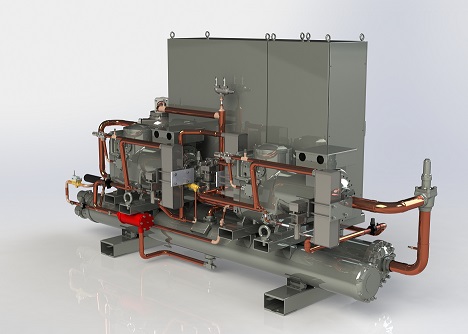Water Source Heat Pumps
An Open Water Heat Pump system works by recovering the solar energy stored naturally in river water or open water. The water then passes through heat pumps to yield its low grade heat before being returned to the river with a temperature change of 3°C.
The Energy Secretary has described water source heat pumps as "game changing" in relation to Britain's need for renewable energy against the backdrop of insecurity in Russia, which supplies much of Europe's gas, and the political row at home over soaring fuel bills.
DECC has drawn up a Water Source Heat Map showing where renewable heat can be drawn from water to exploit the potential of heat pumps. Any large body of water, including tidal rivers as well as standing water can be used. The Government has a target of 4.5 million heat pumps across Britain.
The late Sir David MacKay, the chief scientific adviser to DECC and professor of engineering at Cambridge, has described a combination of heat pumps and low carbon electricity as the future of building heating.
Water source heat pumps benefit from the thermal inertia of river water
A heat pump can concentrate heat by compressing refrigerant gases into a small volume and then transferring the heat into buildings to provide warmth via heat exchangers. The refrigerant gas becomes cold when the pressure is released and this coldness can be exchanged with warmer water from the river – and the cycle can be repeated continuously. The effect is to transfer heat from the river into the building to heat the flats.
Some interesting points to note:
- heat pumps will become more common as the UK decarbonises its heating systems
- the use of heat pumps is growing as the government subsidises low-carbon heat sources with the Renewable Heat Incentive
- air source heat pumps, which heat exchange with ambient air, are cheaper to install than ground source heat pumps, but they are at their least efficient on the coldest days when they are most needed.
- The river is warmer than the air in winter, so a water source heat pump is more efficient than an air source heat pump – because of the thermal inertia of the water from the previous summer.
- The ground is also warmer than the air, so a ground source heat pump is also more efficient than an air source heat pump – because of the thermal inertia of the ground from the previous summer.
It is possible to go one major step further in exploiting the thermal inertia of the immoveable thermal mass of the ground – by adding solar heat to the ground in summer in order to recycle the heat with a heat pump the following winter: Underground Thermal Energy Storage.
Advantages of Water Source Heat Pumps
Water has a high capacity to hold heat in relation to its volume; it readily absorbs heat and readily delivers it: it enjoys a high transfer rate. It is more efficient for a heat pump to exchange heat with water than air – which enables a water source heat pump to outperform and air source heat pump. A ground source heat pump also uses water to transfer heat from the ground to its heat pump.
The thermal capacity and thermal inertia of water enables it to retain some of the solar heat gained in the summer through to the winter. River water, and groundwater in aquifers, will be warmer than the air temperatures on cold winter days and thus provide a more attractive input temperature to a heat pump.
A well engineered water source heat pump system has access to a large volume of water: this enables it to extract heat from a very large heat source whose temperature will not change significantly as relatively small amounts of heat are extracted from it. For heat extraction from a flowing river there will be no change to the inlet temperature from the river if the discharge is downstream of the abstraction point.
Disadvantages of Water Source Heat Pumps
The disadvantages of an open loop water source heat pump system include the need to meet the additional engineering challenges of dealing with open water which may contain debris, unstable pH values or biological growth and may call for additional pumping loads. It will also be necessary to meet the abstraction requirements of the Environmental Agency on all but the smallest of schemes. Most of these problems can be sidestepped by employing a closed loop system with heat exchangers immersed in the river or in open water.
The key disadvantage of using a very large body of water to achieve heat exchange with a relatively constant temperature is that you are not able to store summer heat in that body of water – to have the benefit of retrieving those higher temperatures in winter.

High Temperature Water Source Heat Pumps
The CoP of a heat pump will generally improve the lower the output temperature delivered: therefore the designer aims for a well designed heat emitter system such as underfloor heating where 40°C is sufficient to provide comfortable temperatures. However, if a heat pump is to be used in an existing building with limited heat emitters for the heat load, such as undersized radiators, then it may be appropriate to specify a high temperature heat pump to avoid the disruption that would be caused by refurbishing the heat emitter system.
There are now heat pumps capable of delivering output temperatures of 80°C which is more than sufficient for DHW needs and to warm a building with undersized radiators. Although the CoP will fall if output temperatures are raised to 80°C, a well designed inverter-driven high temperature heat pump with a good control system, including weather compensation, will only deliver 80°C when it is required: otherwise it will modulate the heat pump to deliver lower temperatures – at a higher efficiency – when the heating load is below peak requirements.
ICAX has installed high temperature water source heat pumps at:
- Balanced Energy Network: a groundwater heat pump system at London South Bank University
- Robinson College, Cambridge: a river source heat pump system at Cambridge University
- Community Housing Estates: in the London Borough of Southwark

Heat pumps can play an important role in balancing supply and demand
It has been said that: "Heat pumps could also play an important role in balancing supply and demand in future energy systems. Electricity is difficult to store, but heat can be stored easily in the form of hot water."
In fact, heat pumps will be able to play a far more significant part when it is understood that heat pumps can do much more than store a small amount of heat overnight in small hot water tanks: heat pumps can play a significant part in interseasonal heat transfer systems when the ground itself can be used as a very large store of solar heat energy from summer to winter.
District Heating Networks
Groundwater heat pumps are ideal for providing heating and cooling on district heating networks: the optimum arrangement to enable heat recycling and avoid heat losses in the circuit is to use a heat sharing network. A heat sharing network circulates water at ambient ground temperature to a set of buildings, each of which can use heat pumps to extract heat when they need heating — and reject heat when they need cooling.
In a retrofit installation it is likely that a high temperature heat pump will be needed to avoid the need for refurbishing heat distribution systems already in place.
ICAX is involved in the design and installation of the following district heating schemes based on heat pumps:
- Balanced Energy Network: an open loop aquifer system at London South Bank University
- Community Heating Southwark: a set of open loop aquifer systems in Southwark
- Owen Square District Heating: a closed loop system at Easton, Bristol, including summer recharge.
See Ground Source Heating Ground Source Cooling Ground Source Energy



